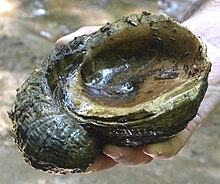Exogyra
|
Exogyra Temporal range: Jurassic-Cretaceous |
|
|---|---|
 |
|
|
Exogyra flabellata (Owl Creek Formation, Late Cretaceous, Mississippi) |
|
| Scientific classification | |
| Kingdom: | Animalia |
| Phylum: | Mollusca |
| Class: | Bivalvia |
| Order: | Ostreoida |
| Family: | Gryphaeidae |
| Subfamily: | Exogyrinae |
| Genus: | †Exogyra |
| Species | |
|
|
Exogyra is an extinct genus of fossil saltwater oysters, marine bivalve mollusks in the family Gryphaeidae, the foam oysters or honeycomb oysters. These bivalves grew cemented by the more cupped left valve. The right valve is flatter, and the beak is curved to one side. Exogyra lived on solid substrates in warm seas during the Jurassic and Cretaceous periods.
The subgenus Aetostreon is sometimes considered a separate genus, due to a lack of the fine set of parallel ribs (chomata) separated by pits, on the inner surface of the valves (which is present in the nominate subgenus).
Exogyra (subgenus Aetostreon) (Bayle, 1878)
Fossils of Exogyra have been found in:
Afghanistan, Chile, China, Eritrea, Ethiopia, France, Germany, India, Kenya, Poland, Portugal, Somalia, Spain, Tanzania, the United Kingdom, and Yemen.
Afghanistan, Algeria, Argentina, Brazil, Canada (British Columbia), Chile, Colombia (Hiló Formation, Tolima), Cuba, the Czech Republic, Egypt, Ethiopia, France, Germany, Greenland, Hungary, India, Iran, Italy, Jordan, Lebanon, Libya, Madagascar, Mexico, Morocco, Mozambique, New Zealand, Nigeria, Oman, Pakistan, Peru, Poland, Portugal, Serbia and Montenegro, Slovakia, South Africa, Spain, Sweden, Switzerland, Tanzania, Trinidad and Tobago, Tunisia, Turkey, USSR, Ukraine, the United Kingdom, United States (Alabama, Arizona, Arkansas, California, Colorado, Delaware, Georgia, Maryland, Minnesota, Mississippi, Missouri, Montana, New Jersey, New Mexico, North Carolina, Oklahoma, South Carolina, Tennessee, Texas, Utah, Wyoming), Venezuela, and Yemen.
...
Wikipedia
